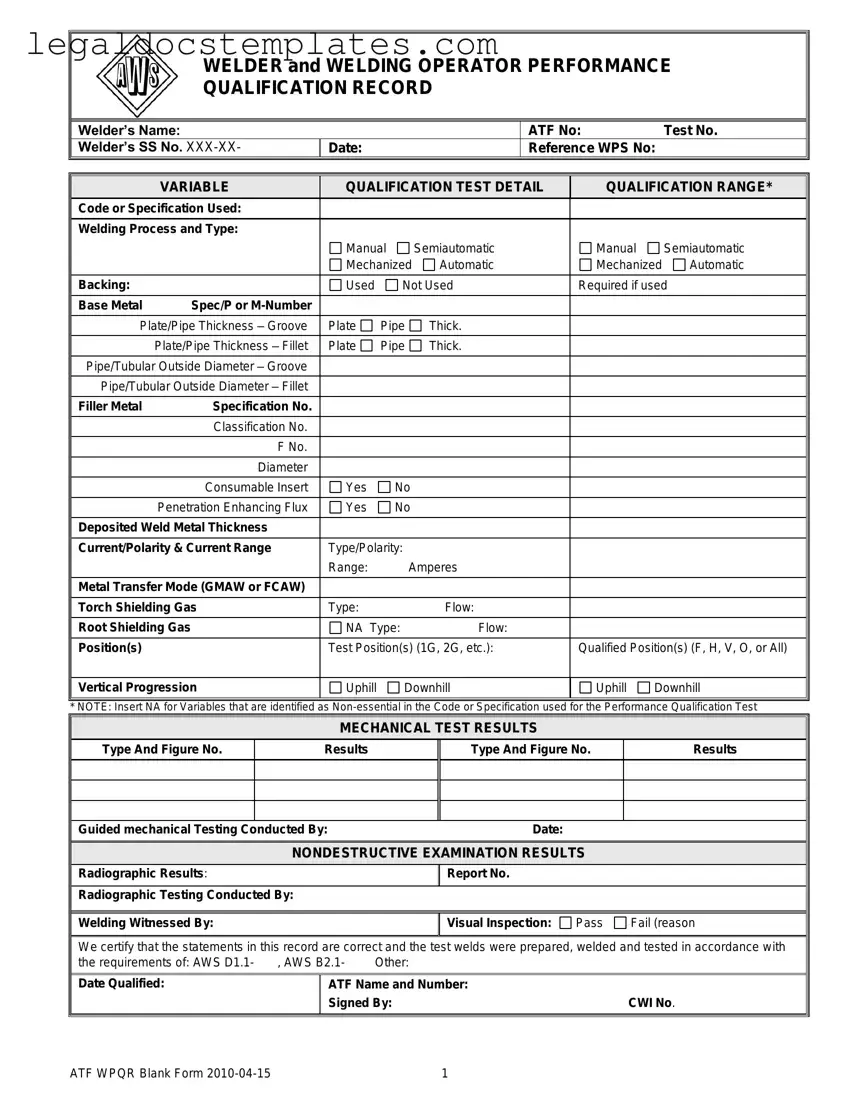The Certification of Welding Inspectors Form closely resembles the Welder Performance Qualification Record form in its use of specific criteria to gauge competency. This form records the qualifications of an individual not based on their welding skills but on their ability to inspect welds, ensuring they meet certain standards. Like the Welder Performance Qualification, it involves detailed entries including the inspector's identification, areas of expertise, testing results, and certifications received, ensuring the individual’s proficiency is thoroughly documented and validated against industry standards.
A Material Test Report shares similarities with the Welder Performance Qualification Record form in terms of recording important test results. Material Test Reports detail the properties and the compliance of materials to specified standards, including chemical compositions and mechanical properties. Conversely, the Welder Performance Qualification Record focuses on the qualifications of the welder and the parameters of the welding process. Both documents serve as critical records that validate compliance with industry standards, maintaining a focus on quality and safety.
The Welding Procedure Specification (WPS) is another document that mirrors the structure and intent of the Welder Performance Qualification Record form. However, while the Welder Performance Qualification Record focuses on the welder’s ability to perform under specific conditions, the WPS outlines the welding process itself, providing detailed instructions for welders to follow to ensure a successful weld. Both documents require detailed technical specifications and are foundational to achieving and demonstrating compliance with quality and safety standards in welding operations.
A Job Safety Analysis (JSA) form, while primarily focused on safety rather than performance qualification, also shares some similarities with the Welder Performance Qualification Record form. A JSA form evaluates job tasks to identify risks and determine controls to mitigate hazards. Similar to the qualification record, it methodically breaks down tasks to assess critical components - in this case, focusing on safety rather than skill competency. Both forms play crucial roles in establishing protocols that ensure workplace safety and regulation compliance.
The Quality Control Checklist for Welding is akin to the Welder Performance Qualification Record, with both emphasizing the adherence to predetermined standards. This checklist is used during or after welding to ensure all aspects of the weld meet quality requirements. Similar to the qualification record, this checklist gathers data on welding processes, materials, and final outcomes, contributing to the overall assurance of project standards and compliance.
The Welder Continuity Log is comparable to the Welder Performance Qualification Record form in its record-keeping function. It tracks a welder’s active status in performing certain welding tasks, ensuring their qualifications remain valid over time. While the Welder Performance Qualification Record certifies a welder’s ability at a single point in time, the Welder Continuity Log maintains an ongoing record of their work to preserve the continuity of their certification, highlighting both documents' roles in credential maintenance.
A Non-Destructive Testing (NDT) Report parallels the Welder Performance Qualification Record form in aiming to ensure the integrity of welds without damaging the materials. While NDT Reports focus on the results of specific testing methods such as radiography or ultrasonic testing, the Welder Performance Qualification Record documents a welder’s ability to produce quality welds. Both are instrumental in maintaining high standards of safety and quality in welding projects.
The Employee Training Record shares a similar purpose with the Welder Performance Qualification Record, focusing on documenting the training and proficiency of personnel. Although more general in nature and not limited to welding, Employee Training Records capture details of skills gained, assessments passed, and certifications achieved, akin to how the Welder Performance Qualification Record documents a welder’s ability to meet specific welding standards.
The Inspection Test Plan (ITP) represents yet another document bearing resemblance to the Welder Performance Qualification Record form by delineating standards for ensuring quality throughout the production process. The ITP outlines the points of inspection and the criteria for acceptance at each phase of construction or production, similar to how the Welder Performance Qualification Record specifies the standards a welder must meet. Both documents contribute significantly to the overarching goal of quality assurance in projects.

